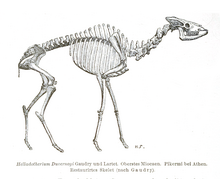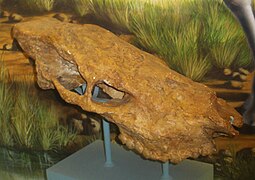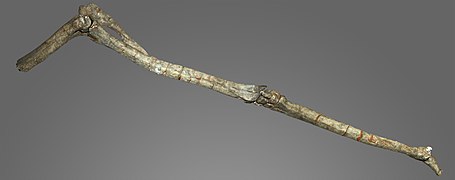| Helladotherium Temporal range: Miocene
| |
|---|---|

| |
| Skeleton of Helladotherium duvernoyi | |
| Scientific classification | |
| Domain: | Eukaryota |
| Kingdom: | Animalia |
| Phylum: | Chordata |
| Class: | Mammalia |
| Order: | Artiodactyla |
| Family: | Giraffidae |
| Genus: | †Helladotherium |
| Species | |
|
†H. duvernoyi | |
Helladotherium is an extinct genus of sivatheriine giraffid from Europe, Africa, and Asia during the Miocene.[1] The most complete skeleton is that of a female, based on a comparison with an intact female Sivatherium giganteum skull.
Only two species of Helladotherium have been discovered, with H. grande being larger than H. duvernoyi. The former has been found only in Pakistan.[2]
List of species
[edit]- Helladotherium duvernoyi
- Helladotherium grande
-
Skull
References
[edit]- ^ Roussiakis, S; Iliopoulos, G. "Preliminary observations on the metrical variation of Helladotherium duvernoyi and Bohlinia attic" (PDF). University of Athens. Retrieved 7 June 2019.
- ^ Iliopoulos, George (2003). The Giraffidae (Mammalia, Artiodactyla) and the study of the histology and chemistry of fossil mammal bone from the Late Miocene of Kerassia (Euboea Island, Greece) (Report). University of Leicester. p. 93.
Sources
[edit]- The Evolution of Artiodactyls by Donald R. Prothero and Scott E. Foss
- Mammoths, Sabertooths, and Hominids by Jordi Agusti and Mauricio Anton
- Classification of Mammals by Malcolm C. McKenna and Susan K. Bell
See also
[edit]


Well, that’s interesting to know that Psilotum nudum are known as whisk ferns. Psilotum nudum is the commoner species of the two. While the P. flaccidum is a rare species and is found in the tropical islands. Both the species are usually epiphytic in habit and grow upon tree ferns. These species may also be terrestrial and grow in humus or in the crevices of the rocks.
View the detailed Guide of Psilotum nudum: Detailed Study Of Psilotum Nudum (Whisk Fern), Classification, Anatomy, Reproduction